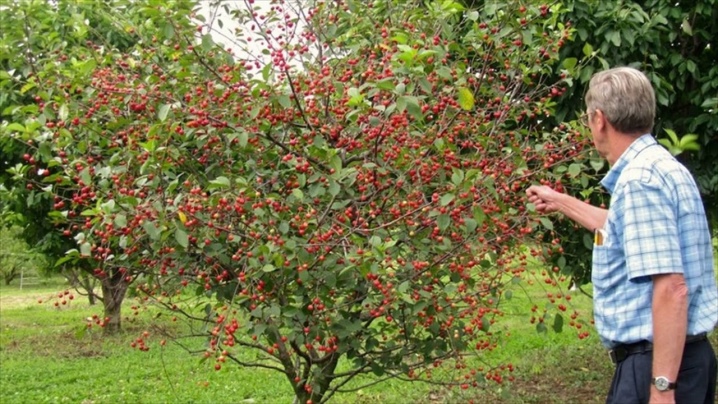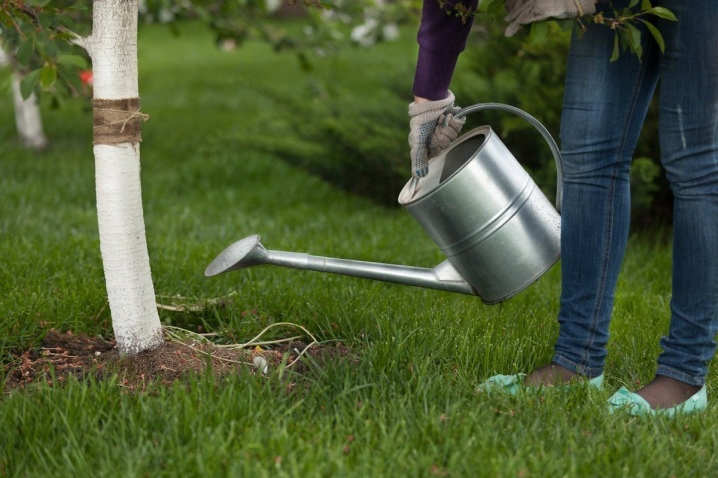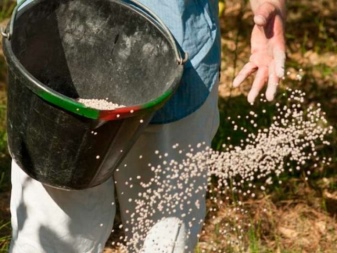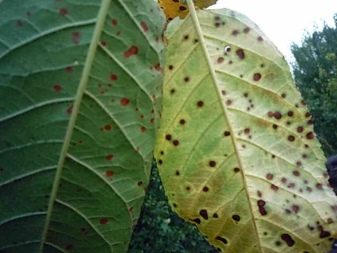The nuances of caring for cherries

Sweet cherry is a fairly well-known berry culture that is loved by many. A wide selection of varieties allows you to choose and plant a tree at your summer cottage, so that you can then feast on juicy and tasty berries. It is very important to ensure that the plant is properly planted and cared for. In this article, we will consider the nuances of caring for cherries, as well as possible problems during cultivation.

Care features
Sweet cherry is a type of cherry that grows in the southern regions of Russia, Ukraine, North Africa, Europe, Western Asia and the Caucasus. Now there is a fairly wide range of varieties that can be planted on your site in the garden or in the country. Many varieties are characterized by increased winter hardiness, they are called northern. They can be easily grown in the suburbs or in the Leningrad region.
In order for the cherry to bear fruit, it is necessary to provide it with proper care. The rules for planting this tree play a huge role:
- it is better to choose a site with sandy loam or loamy soil with a neutral reaction, while you should pay attention that the groundwater passes at a depth of 2 meters;
- it is recommended to plant seedlings in well-lit places that are protected from the winds;
- it is advisable to plant several varieties in one area that bloom at the same time.


If you plant cherries correctly, then it will not be at all difficult to care for them. For the first few years, the plant grows very quickly, forming strong shoots, and there is no need to feed the plant.
Sweet cherry does not need the attention of a gardener, growing well on its own. Usually performing agrotechnical actions, within 5 years there will be a large healthy tree on your site.

Watering and feeding
Sweet cherry does not need frequent watering, since it is characterized by drought tolerance. For an adult tree, only three waterings per season will be enough. They need to be done rarely, but abundantly. The soil should be completely wet. If we talk about young plants, then they need more regular watering than mature trees. It is recommended to water them when the top layer dries up, but it is important not to overflow, since water stagnation is possible, which adversely affects the cherries.

Fertilization is very important for cherries at all stages of plant growth and development. When choosing a fertilizer, you should take into account the age of the cherry, the composition of the soil and the variety. Usually, in order to properly feed a tree, they adhere to the following algorithm:
- in spring, when the buds are blooming, plants at the age of three years can already be fertilized with complexes containing nitrogen, since it stimulates the growth of shoots;
- at the beginning of summer, it is recommended to apply complex mineral fertilizers, you can combine urea, potassium chemicals and superphosphate - usually preparations are used in the form of granules, after they enter the soil, it should be watered abundantly until it is completely dissolved;
- in the fall, the tree again needs feeding, it is recommended to use phosphorus-potassium compounds, but you need to do exclusively spraying on the leaves.
Important! During flowering, trees can already be fed for more than 4 years.
Only root feeding is used. To prepare the solution, you will need 10 glasses of ash and 5 liters of mullein for 50 liters of water. If the tree is no more than 7 years old, only 1 bucket is enough, if the tree is over 8 years old, you need to take 2-3 buckets.


Pruning
Seedlings can only be trimmed when their height is over 70 cm. The lowest lateral shoot should be shortened to 50 cm, all other branches should be cut to the cut level. The guidewire should be no more than 15 cm higher than the skeletal branches. All branches growing at an acute angle to the trunk are recommended to be cut. You should be careful - if only 2 shoots are presented from the sides, then they should be shortened from the base by 4-5 buds. Then the conductor is trimmed 6 buds higher. Already next year it will be possible to lay the lower tier.
Cherry shoots grow rather quickly, but they branch little. To form the crown correctly, you will need to go through several stages.
The finished crown is usually obtained in the fifth or sixth year. Pruning must be done in the autumn season, but before frost.

Already in early spring, sanitary pruning can be done, during which broken or damaged shoots are cut off during the winter, as well as those that grow inside the crown. To process the cuts, it is imperative to use a garden pitch, which will disinfect the cut and protect the tree from various kinds of infections.
If you properly prepare cherries for winter, then she will easily transfer them. It is worth noting that there will be little trimming. It is imperative to thoroughly clean the fallen leaves from under the tree, because it can contain pests and various infections. With the help of lime, the stem should be disinfected, which will have a positive effect on the frost resistance of cherries. Next, the trunk circle is mulched. A young tree must be sheltered for the winter.


Treatment against diseases and pests
Sweet cherry is prone to various diseases, so it is recommended to familiarize yourself with possible diseases and pests initially. Let's take a closer look at the most common diseases.
- Clasterosporium disease - this disease initially affects the shoots, and then gradually passes to the buds and flowers. The prevention of this disease is the treatment with a drug that contains copper. The tree needs triple processing, and they all need to be produced within 14 days.
- Moniliosis - this disease is typical for all stone fruit crops. Rotten berries are a characteristic feature, as well as the presence of dried branches and flowers. When the tree fades, it is necessary to take Bordeaux liquid for processing cherries. With its help, the tree should be sprayed 2 times, adhering to an interval of two weeks. It is necessary to carefully examine the cherries, remove all infected berries and ovaries, as well as affected shoots. The tree must remain clean.
- Coccomycosis - a common disease that manifests itself on the leaves. During rainy weather, the infection spreads rather quickly. The most effective way of fighting is the treatment with the Horus fungicide several times in one season. It is necessary to adhere to the following processing algorithm: first, the crown with buds, the second time after flowering. After about half a month, all affected parts should be removed. Only such treatment will allow you to cope with coccomycosis.


Let us consider in more detail the most common pests that infect cherries.
- Cherry fly Is a rather dangerous pest from which it is almost impossible to save the crop. It destroys about 90% of the crop. The nectar of the flowers and the pulp of the drupes are food for the larvae of the flies. Usually the fly is found on mid- and late-ripening cherry varieties. With the help of special traps, adults are caught. To combat the larvae, the "Confidor" treatment is used 2 times, adhering to an interval of 20 days. In this case, it is allowed to harvest only 20 days after treatment with the drug.
- Leaf roll - caterpillars infect leaf plates, they eat them, and the largest individuals even destroy the fruits themselves.The presence of a leafworm on a tree can be determined by the leaves, which are twisted and pulled together by a cobweb, under which the larvae are located. Cherries must be treated in the spring before budding with an insecticidal solution.
- Trubokvert - a pest whose larvae feed on the nuclei of the bones. To get to them, the pest damages the fruits themselves. Only a double treatment will get rid of this insect. When the cherry has faded, the tree should be sprayed with Aktara solution, and after two weeks it is recommended to repeat the treatment.
- Cherry aphid Are small black insects that hatch from eggs in spring and feed on the juice of young leaves and shoots. The leaves curl up into a tube, dry up and turn black. This insect secretes a rather sticky liquid, resulting in sticky leaves. This is the so-called honeydew, which is very fond of various insects, for example, ants. It is they who become carriers of the cherry aphid on the tree. Insecticides will be required to fight. All infected leaves and shoots must be removed.
- Chafer - this insect loves leaves, but its larvae bring the most harm, it is customary to call them beetles. They have a detrimental effect on the root system of the sweet cherry, as a result, the development of the plant slows down, and if no action is taken, the tree will die. Usually, beetles are active in the first month of summer, then they pupate and hibernate. You need to make bait in the form of a heap of humus or compost. They should be thoroughly wet and covered with slate or roofing material. Soon the beetles will gather in the bait in fairly large numbers. Then there is little to do - to collect all the beetles and destroy.


Possible growing problems
Experienced gardeners know that when growing cherries, you can face the following problems:
- buds bloom late - the reason for this may be a buried root collar when planting;
- freezing of a tree - such a nuisance usually happens when the variety is chosen incorrectly, therefore, all the nuances should be taken into account when choosing a variety, including the region;
- lack of berries - if there is no cross-pollination, then the fruits will not appear;
- discharge of the ovary - if irrigation is carried out with a delay during the growing season;
- the bark of the trunk is cracking - usually this problem occurs after a sunburn, it is imperative to cover up the damage to the bark;
- a poor crop that appears irregularly - this happens in cases where the tree is not pruned;
- the death of cherries - there may be various reasons, such as diseases, the presence of rocks and rubble in the soil, so you need to carefully choose the soil for planting trees;
- yellow leaves - quite often the tree does not have enough iron, which happens when the soil is damp or calcareous;
- the berry cracks - usually this is due to a change in the weather, when prolonged rains come to replace the dry one, but you do not need to leave this problem, because in the future you can even lose the whole tree; for the fight, spraying with a solution of calcium chloride is suitable, the berries can be covered with salt, but before collecting it must be washed off.
Excellent results are shown by the safe product "Vodosbor", since it includes natural resins of coniferous plants.














The comment was sent successfully.